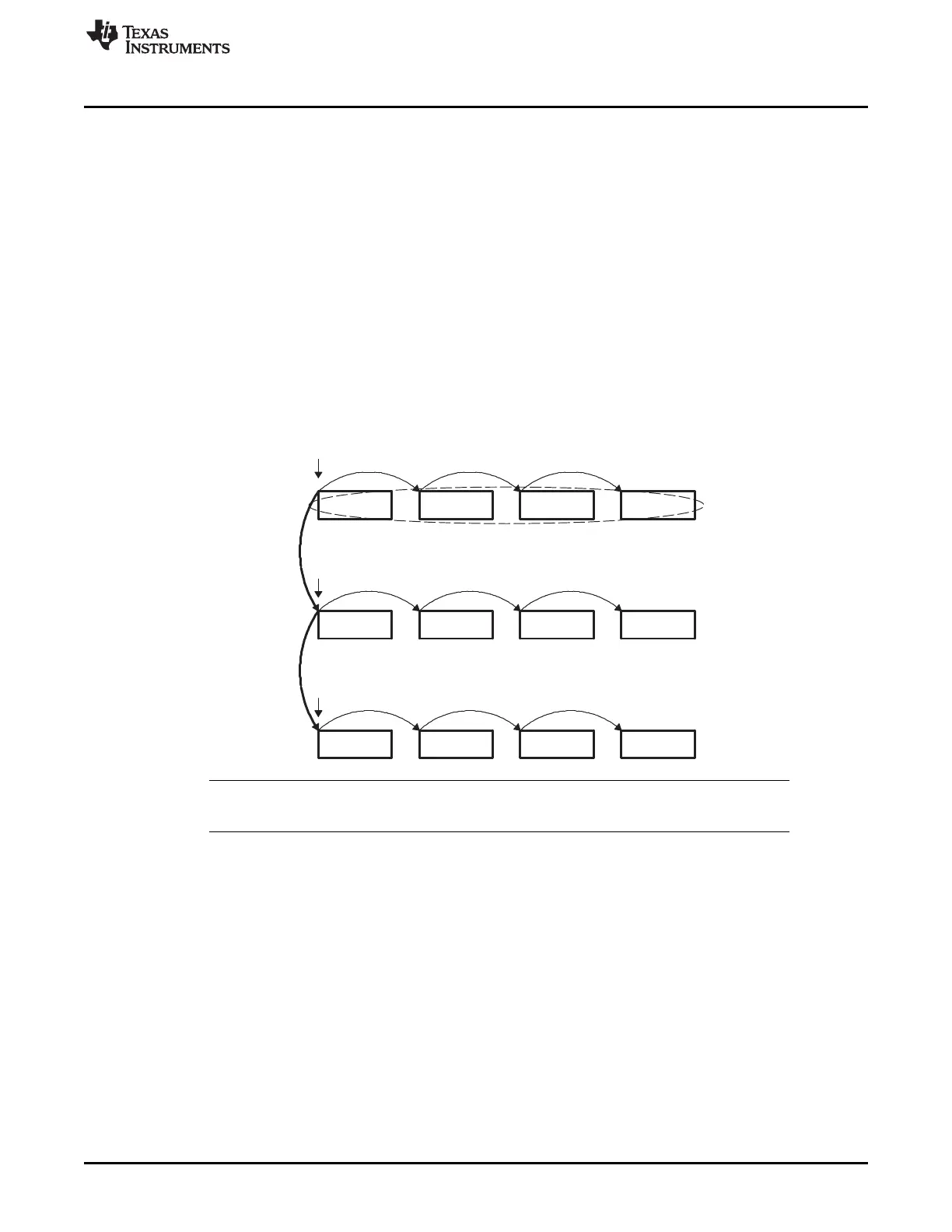Array0 Array1 Array2 Array3
Eacharraysubmit
asoneTR
Array0 Array3Array1 Array2
(SRC|DST)
BIDX
(SRC|DST)
BIDX
(SRC|DST)
BIDX
(SRC|DST)
BIDX
(SRC|DST)
BIDX
(SRC|DST)
BIDX
(SRC|DST)
BIDX
Array0
Array3
(SRC|DST)
Array1
BIDX BIDX
(SRC|DST)
Array2
Frame0
Frame1
Frame2
(SRC|DST)
CIDX
(SRC|DST)
CIDX
AB_Synctransfer
www.ti.com
Functional Description
11.3.2.2 AB-Synchronized Transfers
In a AB-synchronized transfer, each EDMA3 sync event initiates the transfer of 2 dimensions or one
frame. In other words, each event/TR packet conveys information for one entire frame of BCNT arrays of
ACNT bytes. Thus, CCNT events are needed to completely service a PaRAM set.
Arrays are always separated by SRCBIDX and DSTBIDX as shown in Figure 11-8. Frames are always
separated by SRCCIDX and DSTCIDX.
Note that for AB-synchronized transfers, after a TR for the frame is submitted, the address update is to
add SRCCIDX/DSTCIDX to the beginning address of the beginning array in the frame. This is different
from A-synchronized transfers where the address is updated by adding SRCCIDX/DSTCIDX to the start
address of the last array in the frame. See Section 11.3.3.6 for details on parameter set updates.
Figure 11-8 shows an AB-synchronized transfer of 3 (CCNT) frames of 4 (BCNT) arrays of n (ACNT)
bytes. In this example, a total of 3 sync events (CCNT) exhaust a PaRAM set; that is, a total of 3 transfers
of 4 arrays each completes the transfer.
Figure 11-8. AB-Synchronized Transfers (ACNT = n, BCNT = 4, CCNT = 3)
NOTE: ABC-synchronized transfers are not directly supported. But can be logically achieved by
chaining between multiple AB-synchronized transfers.
11.3.3 Parameter RAM (PaRAM)
The EDMA3 controller is a RAM-based architecture. The transfer context (source/destination addresses,
count, indexes, etc.) for DMA or QDMA channels is programmed in a parameter RAM table within
EDMA3CC, referred to as PaRAM. The PaRAM table is segmented into multiple PaRAM sets. Each
PaRAM set includes eight four-byte PaRAM set entries (32-bytes total per PaRAM set), which includes
typical DMA transfer parameters such as source address, destination address, transfer counts, indexes,
options, etc.
The PaRAM structure supports flexible ping-pong, circular buffering, channel chaining, and auto-reloading
(linking).
The contents of the PaRAM include the following:
• 256 PaRAM sets
• 64 channels that are direct mapped and can be used as link or QDMA sets if not used for DMA
channels
• 64 channels remain for link or QDMA sets
881
SPRUH73H–October 2011–Revised April 2013 Enhanced Direct Memory Access (EDMA)
Submit Documentation Feedback
Copyright © 2011–2013, Texas Instruments Incorporated

